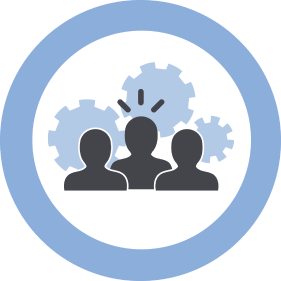Leadership and Management
Intent:
To ensure systematic, intentional, and sustained UDL implementation across the school community, school leaders actively lead and participate in UDL implementation efforts. School leaders continually develop their UDL knowledge and skills, and they collaborate with the school community to establish, monitor and support UDL implementation goals.
Indicators:
School leaders actively and continually:
-
lead UDL implementation efforts across the school;
-
develop their UDL implementation knowledge and skills;
-
model UDL implementation knowledge and skills in communications, interactions, meetings , processes, etc.;
-
monitor the application of UDL knowledge and skills across the school environment and throughout the staff; and
-
provide supportive feedback to staff regarding the application of UDL knowledge and skills across school environments
Resources:
Intent:
To ensure that school-wide UDL implementation is intentional, collaborative, iterative, and data-driven across all four domains (Culture and Environment, Teaching and Learning, Leadership and Management, and Professional Learning). Using an iterative design process, school leaders work with the school community to analyze multiple data sources in order to set, plan and monitor UDL implementation goals. UDL implementation goals focus on improving equity, inclusion and expert learning.
Indicators:
School leaders collaborate to design a systematic UDL implementation process and:
-
create a UDL leadership team;
-
use school data to identify UDL implementation goals that inform UDL implementation priorities;
-
develop and carry out strategic plans to address UDL goals;
-
reassess implementation data and refine UDL goals regularly; and
-
share UDL implementation process, goals, and plans with the school community
Resources:
Intent:
In order to reduce barriers and support the anticipated variability of the school community, school-wide processes are designed and enacted with learner variability in mind. Procedures and structures are equitable, inclusive, flexible, accessible, and promote expert learning.
Indicators:
School leaders collaborate to:
-
use the UDL Guidelines and a systematic design process to review and design school procedures, processes, and structures to ensure they promote equity, inclusion, and expert learning; and
-
regularly monitor and improve the implementation of school procedures, processes, and structures to ensure they promote equity, inclusion, and expert learning.
Resources:
Intent:
To ensure that all learners have equitable access to educational materials and resources. In order to design learning environments and experiences that support the anticipated variability of the school community and reduce barriers to learning, the school community must have access to materials and resources that are accessible, flexible, customizable, and usable by all learners.
Indicators:
School leaders collaborate to:
-
use the UDL Guidelines and a systematic design process to review and select school and classroom resources (e.g., curriculum and technology) that are accessible, flexible, customizable, and usable by all intended learners; and
-
design a systematic process to guide teachers through the selection or creation of classroom resources that align with the UDL Guidelines and are accessible, flexible, and usable by all intended learners.
Anderson, M. (2017). Transformational leadership in education: A review of existing literature. International Social Science Review, 93(1), 4.
https://digitalcommons.northgeorgia.edu/cgi/viewcontent.cgi?article=1213&context=issr
Berquist, E. (2017) UDL: Moving from exploration to integration. CAST Professional Publishing.
Darling-Hammond, L., & Snyder, J. (2000). Authentic assessment of teaching in context. Teaching and Teacher Education, 16, 523-545.
https://doi.org/10.1016/S0742-051X(00)00015-9
Fovet, F. (2020). Integrating Universal Design for Learning in Schools: Implications for Teacher Training, Leadership and Professional Development. Innovations in Educational Leadership and Continuous Teachers’ Professional Development, 295–318. doi:10.46679/isbn978819484832513
Higgins, Monica & Weiner, Jennie & Young, Lissa. (2012). Implementation teams: A new lever for organizational change. Journal of Organizational Behavior. 33. 10.1002/job.1773.
Houchens, G. W., & Keaster, R. D. (2015). Enhancing teacher leadership through instructional rounds: A district case study. In Warrick, D., & Mueller, J. (Eds.), Lessons in changing cultures: Learning from real world cases (pages 345-357). Oxford, UK: Rossi Smith.
Redding, C., & Viano, S. L. (2018). Co-Creating School Innovations: Should Self-Determination Be a Component of School Improvement? Teachers College Record, 120(11), 1–32.
https://www.tcrecord.org/Content.asp?ContentId=22453
Torres, D. G. (2019). Distributed leadership, professional collaboration, and teachers’ job satisfaction in US schools. Teaching and Teacher Education, 79, 111-123.
https://doi.org/10.1016/j.tate.2018.12.001
Waldron, N., McLeskey, J., & Redd, L. (2011). Setting the Direction: The Role of the Principal in Developing an Effective, Inclusive School. Journal of Special Education Leadership, 24, 51-60.
https://eric.ed.gov/?id=EJ96338
Attribution-NonCommercial-NoDerivs
CC BY-NC-ND
This license allows reusers to copy and distribute the material in any medium or format in unadapted form for non-commercial purposes only and only so long as attribution is given to the creator.

